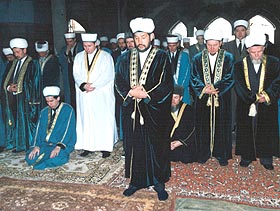Islam in Tatarstan
 | |
With the 16th century Russian conquest, the Tatars lost a great part of their traditional religious institutions. At this time the idea of the Tatar unity became especially important, thus giving rise to a unifying function of Islam as ethno-confessional ideology. Religious and national persecutions by the royalty and Orthodox clergy became the reason of several Muslim uprisings. The Apostolic Synod's Decree "On religious freedom:" of 1773 and Orenburg Religious Assembly of 1788 signified official recognition of the Muslim religion. In the end of the 18th-19th centuries, the Tatar community started to build new social relations. But at this stage, new outlooks, concepts and norms could be viewed only in the light of Islam, which brought forward ideas of religious reformation and Jadidizm as the most acceptable form of intellectual renewal. Islam was an essential attribute of public consciousness up to 1917. The Soviet policy in this sphere was determined by the Decree "On state-church separation" of 1918, essentially limiting religious influence on the society. By the end of 1980s, there were only 18 Muslim communities in Tatarstan (as against 1152 mosques functioning in the Kazan Gubernia in early 1920s).
In 1990s, religious confessions became more active. The Muslim Religious Board (MRB) was set up in 1992. The Tatarstan Muslim Unifying Conference of 1998 elected mufti Gusman khazrat Iskhakov its chairman. As the result of the congress the RT Muslims achieved the organizational unity and created the Religious Board of the RT Muslims as the uniform centralized body.
The main tendency of this period is the statement of inter-confessional stability and forming of Muslim institutes that makes easier the interaction of state bodies with Muslim clergy and normalizes the work inside Muslim religious organizations included in the structure of the RT MRB. The RT MRB consists of 8 departments: educational, scientific, statistical, propaganda and conscription, architectural, vakuf department, press center, international relations department. There are 45 muhtasibats. Religious - judicial authority of the RT MRB is carried out by the main kaziy and the regional kaziyes in Central, East, Southeast, Southwest, Northern, Southern kaziyats. Kazan muftiyat, registered in the RF Ministry of justice, does not show the activity, though in conditions of the organizational split of the Muslims of Russia (more then 40 muftiyats and all-Russian centers) it could gain much importance to many Muslim organizations.
Today, Tatarstan along with Dagestan and the Moscow region is considered a leader among the regions of the Russian Federation in terms of the number of functional religious communities.
The most significant event for the Muslim ummah of Tatarstan was the grand opening of the Kul Sharif Mosque, biggest in the Eastern Europe, on June 24, 2005 in Kazan. Over 5 thousand believers from Russian regions and more than 40 other countries, representatives of the UN, the Council of Europe, well-known Islamic theologians arrived to take part in the event.
The revival processes in the Muslim ummah are not always quiet. The most difficult problem is propagation of various radical currents hidden under the Muslim mask and undermining the traditions of real Islam. The problem of vahhabizm spreading in Russia is especially serious, because it is breaking the religious and national traditions, struggles with the bodies of state authority. The problem of spreading of these pseudo-religions is connected with training of clergy personnel and especially with those who receives religious education abroad. The policy of revival and development of national-religious traditions is carried out for stabilization of the religious situation in Russia particularly in the regions of traditional Islam. The republican high scientific potential is able adequately estimate the revival attempts of obsolete or alien religious forms for Tatar Islam.
 | |
Sunday courses are organized almost in every mosque. According to the RT MRB statistics, Sunday courses are attended by more then 35,000 people. In addition to the RT MRB, Tatarstan has another unique educational establishment – the Educational Center for hafizes of Koran housed in Russian Islamic University (RIU). This educational establishment’s task is to solve one of most vexed problems of Russia’s Muslim society of Russia which is to train those who know the Koran by heart. This centre has been functioning since 2003 and more than 20 hafizes of Koran have already been graduated.